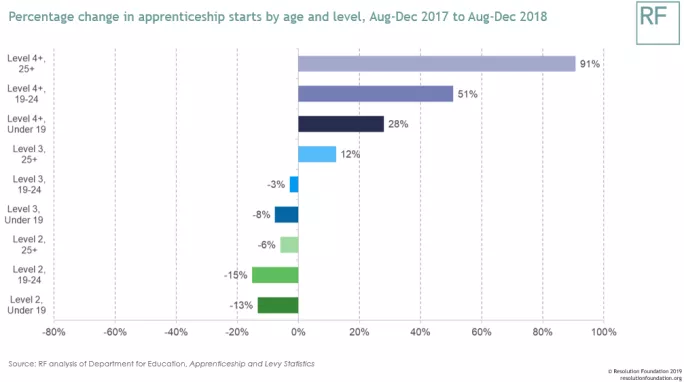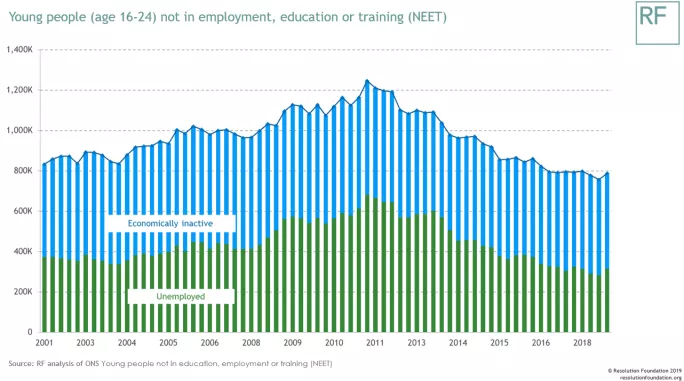- Home
- ‘There is a gap in opportunities for young people’
‘There is a gap in opportunities for young people’

Yesterday, the Department for Education published figures outlining the number of apprenticeships that were started during December 2018, the fifth full month of the 2018-19 academic year. Writing last month about the number and composition of starts, we argued that the apprenticeship system was “finally taking shape”: the sharp (and often, shocking) year-on-year falls that we saw in 2017 had come to a halt. Other trends, such as a shift towards older apprentices and higher-level programmes began to appear less as a “blip” and more as a “pattern”. Did we speak too soon?
Apparently not. The (provisional) total number of starts in December was, at just over 15,000 lower than in previous years (e.g. final figures for December 2017 report just over 20,000 starts) however, when taking a longer view, there were roughly 3 per cent more starts during August-December 2018 (provisional figures) than August-December 2017 (final figures).
Read more: Parents still prefer university to apprenticeships
Background: Government launches £2.5m apprenticeship campaign
Opinion: Drop in younger apprentices ‘could be a major problem’
A continuing pattern
A small change overall, but a far cry from the 20 per cent fall in starts that occurred between August-December 2016 and August-December 2017

Last month, we focused quite a bit on how much the composition of starts has changed in terms of both age and level of study. That pattern continues: year-on-year, we find a reduction in the share of starts taken up at Level 2 (GCSE-equivalent) and growth in the share at Levels 4+. While, at first, most of the falls at Level 2 occurred among older apprentices, we are now seeing reductions in the number of Level 2 apprenticeships started by those age 19 and under. During August-December 2016, there were 34,000 starts taken up by those age 19 and under at Level 2; that number fell to 39,000 over the same time period in 2017 and fell further, to 34,000, in 2018.

At the other end of the scale, the number of starts taken up at Levels 4+ (higher education equivalent levels) by those age 25 and older grew: from 1,600 in 2016, to 2,500 in 2017 and 3,200 in 2018. Looking at the percentage change in the number of starts by age and level gives us a far clearer illustration of the changing patterns that sit below the headline starts number. In the last year alone, the number of starts for older apprentices at higher levels nearly doubled; the number of starts for younger apprentices (i.e. age 19 and under) at Levels 2 and 3 has fallen by 8 and 13 per cent, respectively.

As we’ve noted in the past, the fall in starts for younger apprentices should be a particular cause for concern among government officials - particularly given the education secretary’s call for apprenticeships to form a core component of the post-16 education system. And in fact, Office for National Statistics (ONS) figures on the number of young people not in employment, education or training (NEET), should heighten these concerns. While the number of young people (age 16-24) who were NEET did not change much between October-December 2017 and October-December 2018 (793,000 in 2017 and 788,000 in 2018), these figures - equivalent to 11.3 per cent of 16- to 24-year-olds - remain worryingly high.

This is not to say that apprenticeships are for all young people, nor to suggest that apprenticeships are the answer to unequal educational outcomes. It is to say, however, that there is clearly a gap in education and training opportunities for young people - and that is why we should view the new shape of the apprenticeships system with some concern.
Kathleen Henehan is research and policy analyst at the Resolution Foundation. The graphs are based on Resolution Foundation analysis of the Department for Education’s monthly apprenticeship figures
Keep reading for just £1 per month
You've reached your limit of free articles this month. Subscribe for £1 per month for three months and get:
- Unlimited access to all Tes magazine content
- Exclusive subscriber-only stories
- Award-winning email newsletters



